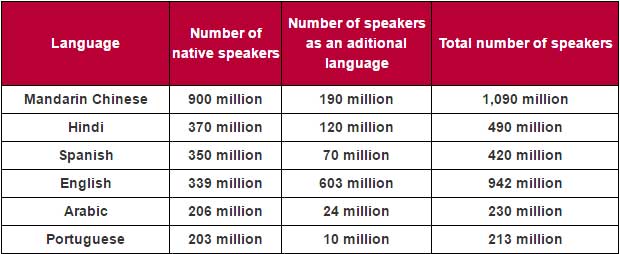IELTS Writing Task 1 | Popular Languages IELTS Writing Task 1 | Popular Languages Instructions: Visual data adopted from https://www.ielts-exam.net/ The table above offers us some information about the most popular languages with the most native speakers. Summarize the information by selecting and reporting the main points. You could make comparisons when necessary. LELB Student: Karim The table indicates six favorite languages (mandarin Chinese, Hindi, Spanish, English and Arabic) spoken the most in the world as a native speakers and as an additional language speakers. The Mandarin Chinese has the most number of native speakers (900 million speakers) while English has the most ...
Home » IELTS Essay Writing Practice » IELTS Writing Task 1 | Popular Languages

IELTS Writing Task 1 | Popular Languages
Updated: by Dr. Mohammad Hossein Hariri Asl
Time to Read: 4 minutes | 308 Views | 2 Comments on IELTS Writing Task 1 | Popular Languages
Share This Post
About the Author
Dr. Mohammad Hossein Hariri Asl is an English and Persian instructor, educator, researcher, inventor, published author, blogger, SEO expert, website developer, entrepreneur, and the creator of LELB Society. He's got a PhD in TEFL (Teaching English as a Foreign Language).
Number of Posts: 4235



The table indicates six favorite languages (mandarin Chinese, Hindi, Spanish, English and Arabic) spoken the most in the world as a native speakers and as an additional language speakers.
The Mandarin Chinese has the most number of native speakers (900million speakers) while English has the most number of speakers as an additional language (603million speakers) among these six languages.
The lowest use of language in both form (native and additional language speakers) belong to Portuguese (203 million and 10 million speakers respectively) so Portuguese has the lowest uses in sum of speakers.
English is only language that number of speakers as an additional language is more than number of native speakers. This shows us that English is the most favorite language that people tend to learn in the world.
After Mandarin Chinese, the Hindi has more uses as a native language (370 million speakers) and after English, the Mandarin Chinese has more uses as an additional language (190 million speakers). Number of native speakers for Spanish and English are 350 million and 339 million respectively. The most sum of speakers belong to Mandarin Chinese speakers (1.09 billion speakers) and English has second portion among these 6 languages (942 million speakers).
Dear Karim,
Thank you so much for submitting your IELTS report on popular languages to us for analysis and assessment.